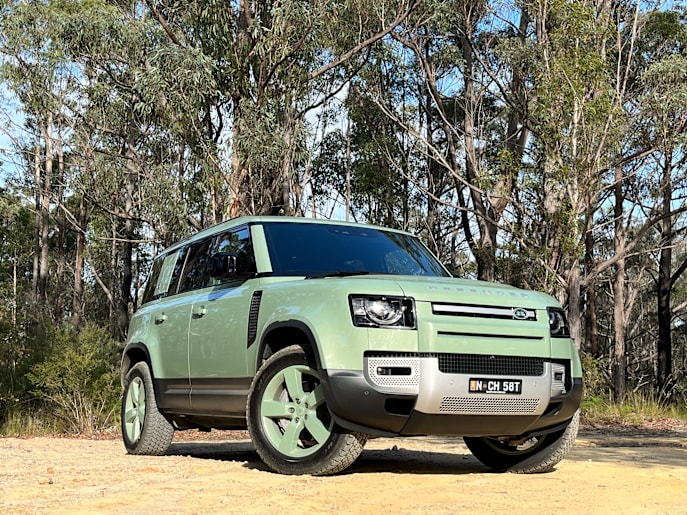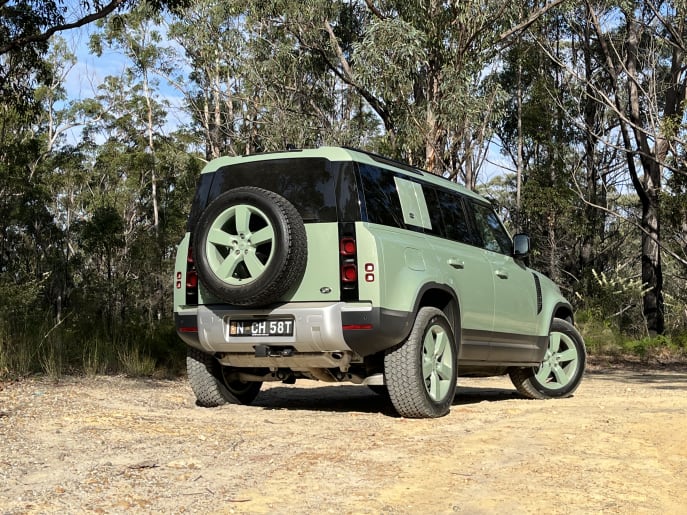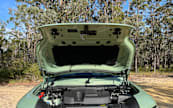To mark 75 years since the original Land Rover, the Series I, was released, Jaguar Land Rover is selling 75 of its 75th anniversary Defenders in Australia – 25 Defender 90s and 50 Defender 110s.
We had a 110 for a week of mixed driving, but with a lot of off-roading thrown in for good measure.
But is this limited-edition Landie really worth more than $150,000?
Price and features of the 2023 Land Rover Defender 110 P400
The 75th anniversary Defenders are based on the high-grade HSE variant and are available in the three-door 90 body style, or the five-door 110 body style.
Our test vehicle, a 110, has a recommended retail price of $156,157, but that price-price-tag does not include on-road costs.
Each special Defender is a P400 MHEV (mild hybrid electric vehicle), so it has a turbocharged 3.0-litre inline six-cylinder petrol engine, supported by a small electric motor.
Some of the more notable items on this Landie’s features list include a 11.4-inch Pivi Pro multi-media system, 3D surround camera, configurable Terrain Response system, Meridian sound system, Matrix LED front lighting, head-up display, wireless device charger, as well as 14-way power-adjustable front seats with heating, cooling and memory, a sliding panoramic glass sunroof and three-zone climate control.
Elements specific to the 75th anniversary Defender include an exterior paint finish of Grasmere Green, as well as 20-inch alloy wheels in the same colour, with matching centre caps. There is also a ‘75 years’ graphic, Ceres Silver bumpers and privacy glass. Inside, the Cross Car Beam is finished in brushed Grasmere Green powder coat, the interior is Ebony and there are “Ebony grained leather seat facings”, according to JLR.
Defender buyers can further add to their vehicle with a bunch of accessories and Packs, which include grouped accessories to suit your specific lifestyle, i.e. Adventure, Explorer, Country or Urban.
The new Defender manages to retain the old Defender’s distinctive shape and spirit while introducing the new-generation’s style and presence into the mix – and this 75th anniversary edition’s striking, like-it-or-loathe-it Grasmere green exterior and its interior touches all complement that blend.
The cabin has a premium look and feel, without sacrificing any practicalities. It’s a nice mix of durable materials – carpet mats and soft-touch surfaces – and stylish touches, such as a metal Defender-stamped section in front of the front passenger.
The leather steering wheel and shifter are standard, but a premium non-leather wheel is a no-cost option.
Layout is user-friendly with all controls easy to locate and operate.
Storage spaces include a centre console, glovebox, twin cup holders in between driver and passenger, sunglass storage, door pockets and shallow spaces for your wallet, phone etc.
Charge points include USBs up front and a wireless charging tray.
The driver and front passenger get plenty of room and amenities and those behind them also fare well with adequate room.
All seats are very comfortable – can this really be a Defender? – and the front seats are 14-way power-adjustable with heating, cooling and memory.
The second row – a 40:20:40 folding configuration – is heated and has a centre armrest.
The rear cargo area seems a bit small in this five-seater, although it offers a claimed 1075 litres of space. With the second row folded down, there is a listed 2380 litres. It has cargo-restraint points.
As mentioned, this Defender is a P400 MHEV (mild hybrid electric vehicle), so it has a 3.0-litre inline six-cylinder turbocharged petrol engine, supported by a small electric motor.
That engine produces 294kW at 5500-6500rpm and 550Nm at 2000-5000rpm and it’s matched to an eight-speed automatic transmission.
The P400 MHEV has a 48-volt lithium-ion battery, aimed at reducing engine load and fuel consumption, and it has a 7kW electric supercharger aimed at minimising turbo lag.
The Defender has permanent all-wheel drive and a dual-range transfer case with high- and low-range 4WD. It has a comprehensive suite of driver-assist tech – including Land Rover’s Terrain Response 2 system, with switchable modes such as Grass/Gravel/Snow, Sand, Mud and Ruts, and Rock Crawl. That system tweaks throttle response, engine outputs, transmission shifts and diff control to best suit the terrain.
It also has centre and rear diff locks.
Our test vehicle also has Land Rover's configurable terrain response system (enabling the driver to select and save powertrain, traction and diff settings for off-road driving) and a wade programme, which increases air-suspension ride height and closes off HVAC vents to reduce the ingress of moisture in the air.
Driving the 2023 Land Rover Defender 110 P400
This 110 variant is 5018mm long (including the rear-mounted spare tyre) with a 3022mm-long wheelbase, 2008mm wide and 1972mm high.
It has a turning circle of 12.8m and a kerb weight is 2297kg, but it consistently feels dynamic to drive.
This Defender has an official 0-100km/h sprint time of 6.0 seconds. Throttle response is sharp, and the 3.0-litre petrol’s 294kW and 550Nm are available for an energetic standing-start, or to safely overtake another vehicle on the highway – or even during low-range 4WDing when throttle control and response are crucial.
It has a listed maximum speed of 191km/h.
The Defender has a real planted feel on the road; it’s composed and very comfortable, no matter how hard you drive it.
The eight-speed automatic transmission is very clever but the shifter’s size (stubby) and position (just under the multimedia system’s touchscreen) make it a bit annoying to use.
The Defender is very quiet and refined, with a nicely cocooned cabin.
Our test vehicle was on 20-inch rims and 255/60 R20 Goodyear Wrangler all-terrain adventure tyres, which are fine for driving on sealed surfaces – but not so much for 4WDing.
So, has it lost any of the ol’ Defender magic? Not at all. This new version does what older generation Defenders can do and more – but it does everything with supreme levels of comfort and composure, which older-generation Defender definitely could not do.
The Defender has a claimed 228mm-291mm of ground clearance (courtesy of height-adjustable air suspension) and a wading depth of 900mm (again, due to the air suspension). If the Defender’s belly hits dirt, the air suspension automatically applies an emergency 75mm of extra height.
This Defender has approach, ramp (breakover) and departure angles of 38 degrees, 28 degrees, and 40 degrees respectively.
This Landie was always stable and composed along the rutted and potholed track to our 4WD testing ground. Much of the credit for that must go to a robust monocoque chassis, as well as a multi-link set-up and fully independent air suspension, which all works well to smooth out surface imperfections at all speeds.
With the air suspension raised to off-road height and tyre pressures dropped to 26 psi, we put the Defender through its paces at our 4WD testing and proving ground. The terrain here is a mix of steep rocky hill-climbs, slippery descents, mud-holes and water-crossings and, depending on the weather, it can either be seriously challenging or pretty bloody dangerous. I’ve seen modified 4WDs struggle to get through this course.
However, as expected, the Defender did everything – and did it all with ease. I’ve driven an all-conquering 90 at this test site before and this 110 was just as impressive.
Steering has a light but precise feel about it at low speeds and that's crucial for such a big vehicle during low-range 4WDing, especially when picking your right line on challenges or manoeuvring along tight, twisted tracks.
There’s plenty of low-down torque from the petrol engine and in low-range that’s evenly applied.
The Pivi touchscreen system is the new Defender’s command centre and, using it, you’re able to cycle through the terrain response programs, you can set driving modes, and essentially operate everything.
The terrain response system, which enables the driver to dial through driving modes, including Mud and Ruts, and Rock Crawl is a clever set-up, giving the driver the ability to calibrate the system’s responses – acceleration, traction sensitivity, diff control and more – to suit the conditions and your driving style.
The tread on the Defender’s Goodyear Wrangler all-terrain tyres quickly became gummed up with mud and so we lost some valuable traction from those tyres on tricky rock steps.
Wheel travel is decent with the Defender able to get practical flex out of that multi-link set-up and air suspension combo.
The new Defender is very capable, and comfortably so, but it feels a little bit too clinical and calculated in its execution.
The Defender has a claimed maximum unbraked capacity of 750kg and a maximum braked towing capacity of 3500kg. It has a maximum roof load of 300kg. GVM (gross vehicle mass) is 3165kg and GCM (gross combined mass) is 6665kg.
Fuel consumption is a claimed 9.9L/100km (on a combined cycle), but we recorded actual fuel consumption on test of 11L/100km.
The Defender has a 90-litre tank so, going by that fuel-consumption figure, you could reasonably expect a driving range of just under 800km on a full tank, factoring in a safe-distance buffer of 20km; 818km without the buffer.
The Defender range has the maximum five-star ANCAP safety rating from testing conducted in 2020.
It has plenty of safety gear as standard and driver-assist tech includes AEB, adaptive cruise control, driver condition monitor, blind spot assist, lane keep assist, a 3D surround camera, 360° parking aid, traffic sign recognition and adaptive speed limiter, and more.
It also has other tech, such as ‘transparent’ bonnet view, wade sensing, tyre pressure monitoring system, and tow hitch assist, which comes in handy for on- and off-road tourers.
It has ISOFIX points on the second-row outboard seats only.
The Defender has a five year/unlimited km warranty with five years roadside assistance.
Service intervals are set for every five years or 102,000km (maximum), whichever occurs first – and that’s for a total cost of $2250.
What we think of the 2023 Land Rover Defender 110 P400
The new Land Rover Defender is refined, comfortable and more than capable off-road.
While the old Defenders were great for their own reasons, the new-generation Defenders have embraced the future – in terms of creature comforts, drive-ability and safety – while losing none of the traditional Defender spirit.
The 75th anniversary treatment doesn’t add anything substantial to the Defender experience, but Landie fans love it anyway.



















